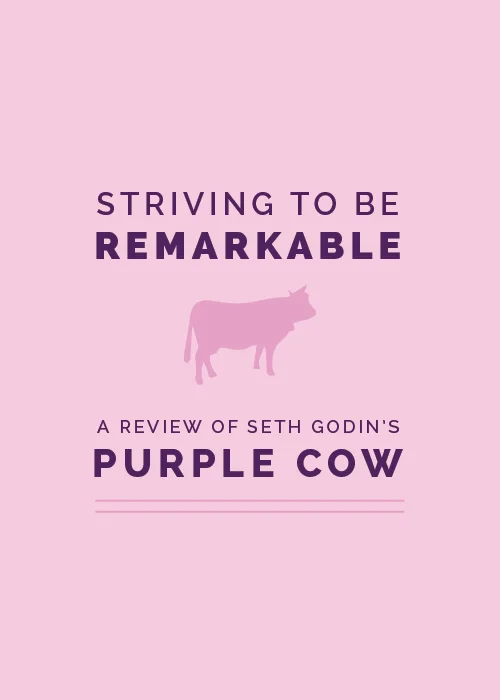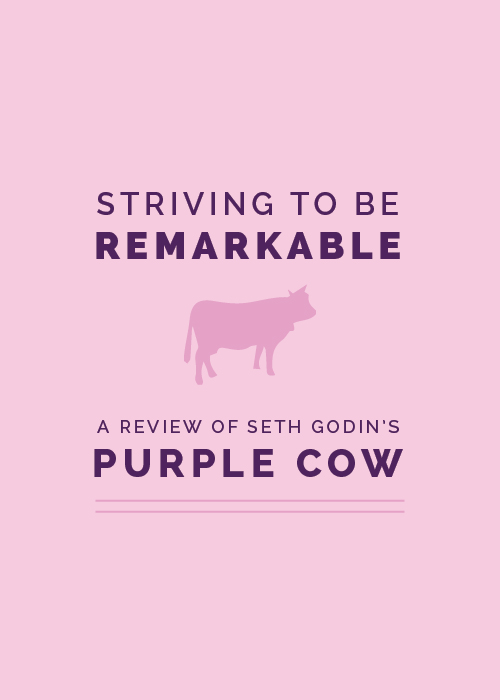Last month I introduced a new Elle & Company blog series called the Business Book Club. My hope with this series is to start a discussion, challenge one another to dive into great business resources, and learn more from the pros on what it takes to grow a successful business.
The first book selection for May was Purple Cow by Seth Godin. Although this book is small (I finished it within a few quick flights between Charlotte and Grand Rapids), it's dense. It would take several posts to cover all of Godin's great insights and examples of modern marketing, so today I'm highlighting my biggest takeaways from the book. However, I would love for this to be a discussion. Join in the comments to tell me about your biggest takeaways, respond to other comments, and/or use the prompts at the end of each section to give me your feedback. Also be sure to scroll down to the end of the post to see the selection for June!
Out with the old, in with the new
Godin begins by discussing the former P's of successful marketing: Product, Pricing, Promotion, Positioning, Publicity, Packaging, Pass-Along, Permission. He goes onto say that in today's market, the old P's just aren't cutting it, and he argues that in order for a company to be successful, they have to strive after a new P: Purple Cow.
A purple cow is remarkable. It sticks out like a sore thumb among the other cows, it draws attention, and it's memorable. It's worth talking about, it's perplexing, and it's far from boring. In order to keep your business from being just like the rest in a crowded industry, you have to switch it up and strive after transforming your business into a purple cow.
I don't have much of a marketing background, so I found it really interesting to read about the former way of successfully marketing a product or service. Companies used to spend the most time and effort into creating a product, and it was up to the marketing department to make that product appeal to a specific audience. If you had a good product and terrible marketing, you had very little chance of success.
Godin gives a great example: "In 1912, Otto Frederick Rohwedder invented sliced bread. What a great idea: a simple machine that could take a loaf of bread and ... slice it. The machine was a complete failure ... It wasn't until about twenty years later - when a brand called Wonder started marketing sliced bread - that the invention caught on. It was the packaging and the advertising ("build strong bodies in twelve ways") that worked, not the sheer convenience and innovation of slicing bread (6)."
Nowadays, Godin says that the innovators and creators of products should also be the marketers; the two have to join forces in order to create something remarkable and appeal to an audience.
What do you think about the concept of the purple cow? Do you agree that the old marketing tactics just won't cut it in today's market?
Your business needs sneezers
Godin describes a sneezer as someone who spreads an "ideavirus." They're more than willing to tell everyone they know about your awesome product or service, and every market needs them. In order to create an ideavirus within your business, you have to find and woo sneezers. And in order to woo them, you have to target a niche. By focusing on a specific segment of people within a market, you can overwhelm them with your idea, causing them to respond. In this narrow market, Godin says that the sneezers are more likely to spread the word/virus about your product and start a trend.
"Then, if you're good and you're lucky, that innovation will diffuse. After it dominates the original niche, it will migrate to the masses (40)."
I love this visual of ideaviruses and sneezers, catching onto your product and doing the hard work by marketing your business for you. As with most things, it's easier in theory than it is in practice, but this seems to be the most organic, successful method to creating a sought-after product or service.
Are you going after the masses or have you narrowed your focus to attract the "sneezers" in your industry? What do you think about Godin's "ideavirus" logic?
It's risker to be safe and it's safer to be risky
This phrase is by far one of my biggest takeaways from Purple Cow. It's easy to want to play it safe in business and in life; we're all naturally afraid of risk and uncertainty. There are so few purple cows out there because everyone is following the rules and no one questions the system, and Godin argues that the rules ultimately lead to failure. It's much riskier to be safe and blend in with the masses, and it's safer to be risky and set yourself apart from the rest.
The following quotes were motivating for me:
"In a crowded marketplace, fitting in is failing. In a busy marketplace, not standing out is the same as being invisible (56)."
"You can't know if your Purple Cow is guaranteed to work. You can't know if it's remarkable enough or too risky. That's the point. It's the very unpredictability of the outcome that makes it work. The lesson is simple - boring always leads to failure.*
*Except, of course, when being boring is, in and of itself, remarkable (61)."
"Boring is always the most risky strategy. Smart business-people realize this, and they work to minimize (but not eliminate) the risk from the process."
Do you try to diminish risk by following along with what others are doing in your industry? Or do you embrace the risk and keep boring at bay?
Designers are now fundamental to marketing
In today's market, the marketing must be built into the design of the product. Godin says that the person with the most influence over the success of a product is the one who joins in when the original ideas are being sown. Marketers and designers have to work together now; they're one and the same.
Godin says, "If you are a marketer who doesn't know how to invent, design, influence, adapt, and ultimately discard products, then you're no longer a marketer. You're deadwood (115)."
As a designer, it's no surprise that I found this interesting. But I found it even more interesting because I've tried and failed with the opposite approach. When I first started my freelance business, I tried to create prints, invitations, planners, etc. and then try to market the products to an audience that I didn't have yet. I didn't realize that the marketing and the designing needed to go hand-in-hand; you can't have one without the other.
Do you put more effort into the design of your product or the marketing? Are you attempting one without the other? How could you combine the two?
I really enjoyed Purple Cow, and it caused me to think differently about marketing my business. It was a little scattered at times with examples and content, but it was chocked full of helpful insights and information. I would highly recommend it to those who haven't read it yet (or if you aren't a big reader, you can watch a pretty great summary of it by Godin himself here).
Next month's selection
Give and Take by Adam Grant
I randomly came across Adam Grant talking about this book on TV, and I knew I needed to check it out. In Give and Take, Grant argues against the age-old saying that “the nice guy always finishes last” and focuses on the correlation between success and a business’s approach to interacting with others. The Amazon review gives it a strong recommendation: “Give and Take highlights what effective networking, collaboration, influence, negotiation, and leadership skills have in common. This landmark book opens up an approach to success that has the power to transform not just individuals and groups, but entire organizations and communities.”














